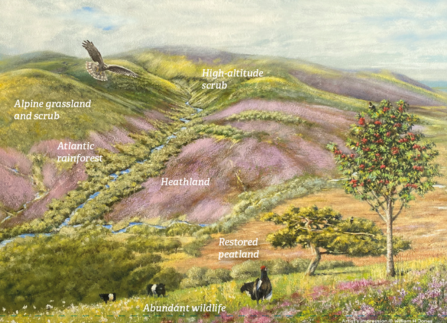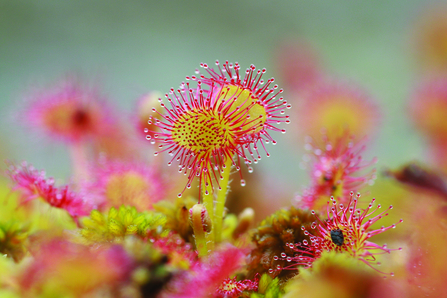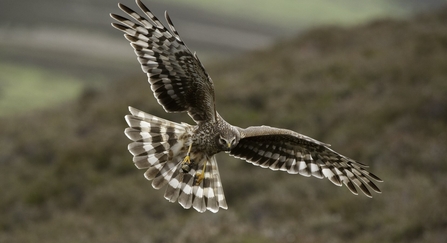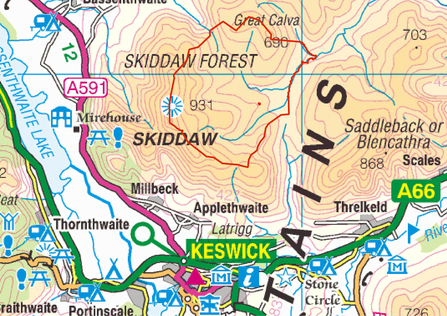Help restore Skiddaw Forest
Please donate to deliver the 100 year vision for nature’s recovery at Skiddaw Forest.
Thanks to our amazing supporters, we've secured 3000 acres of land at Skiddaw Forest and begun the plans to create England highest nature reserve. Donate now to help to restore 990 acres of peatland, create 620 acres of Atlantic rainforest and bring a range of wildlife back to Cumbria’s uplands.
Skiddaw Forest – putting nature into recovery
Cumbria Wildlife Trust has the chance to create a huge new nature reserve at Skiddaw Forest, which will be the highest in England – but this can only be achieved with your help.
This is a once-in-a-lifetime opportunity to put nature into recovery in our uplands. With your support, this world-renowned 3,000-acre wilderness can be protected for nature, forever.
Your support is vital to make this vision a reality. Please help if you can.
We are doing everything possible to secure as much as we can from grants, but we also need donations to lever these funds – which is where you come in.
Your support is needed to put nature in to recovery at the iconic Skiddaw Forest. Thank you.
Your money will initially go towards:
- Carrying out baseline surveys of the wildlife on site
- Sourcing seed and growing native trees
- Tools for volunteers help with our work
- Boundary repairs
- Restoring the 920 acres of peatland
- Planting the first trees on site
- Helping to fund a project officer to oversee the delivery of the restoration
The need for funding is long-term, though the costliest stages will be the initial few years when the need for equipment, tools, specialists and contractors is greatest.
Can you imagine England’s highest nature reserve?
Our 100-year vision for a wilder Skiddaw Forest:

Take a virtual tour of Skiddaw Forest
This long-term nature recovery project will initially focus on four priorities:
1. Creating Atlantic rainforest
A new broad-leaved temperate rainforest woodland, covering roughly 20 per cent of Skiddaw Forest, will be created over the next 100 years or so. Comprising more than 25 species of locally-sourced native trees and shrubs, the woodland on the slopes and ghyllsides will become a rich haven for lichens and mosses, and a home for upland birds, mammals and plants.
2. Restoring Peatlands
Peat bogs cover an extensive area of the lower slopes and the ‘bowl’ of Skiddaw Forest. At 992 acres, this is probably the largest single area of upland peat in the Lake District. Reversing historic drainage is vital to restore it to a healthy and functioning condition to lock away carbon and reduce flood risk downstream.
3. Improving heathland
Recreating high-altitude scrub and alpine-like grassland across 120 acres will return habitat that’s almost entirely absent from the English uplands. Juniper and a variety of willow species will grow in the harsh conditions of the exposed areas beneath the summits.
4. Safeguarding heritage
The Trust will work to preserve the historic heritage and cultural importance of this iconic mountain. It is open access land and a proportion is common land (the rights aren’t currently exercised) – there will be no change to access arrangements or common rights.
Our vision at a glance:

Atlantic oak wood, Achduart, Sutherland, Scotland © Niall Benvie/2020VISION
620 acres of lost Atlantic rainforest returned

Round leaved sundew © Vicky Nall
992 acres of carbon-storing peat bogs restored

Hen harrier Circus cyaneus, adult female in flight approaching nest with food for chicks, Glen Tanar Estate, Scotland, June © Mark Hamblin/2020VISION
More wildlife back and thriving in our fells
Donate now
The story so far
Where is Skiddaw Forest?

Red boundary line shows the area donations can help secure for nature © Ordnance survey
Also known as ‘Back o’ Skidda’, Skiddaw Forest is situated in the north of the Lake District National Park.
From the nearby town of Keswick, the Skiddaw Massif dominates the skyline, forming part of the high-altitude bowl that contains Skiddaw Forest. By ascending one of the surrounding fells and gazing down, the vast expanse of Skiddaw Forest is spread out before you.
Cumbria Wildlife Trust cares passionately about wildlife and wild places – we’re here to put wildlife back into our land and seascapes to make Cumbria a wilder county with more space for nature.
We restore and connect wild places, work with nature to tackle the climate emergency and support people to take local action for wildlife.
With a dedicated team of staff working closely with volunteers, partners and thousands of supporters, together we’re creating a wilder future for Cumbria.
A new future for Skiddaw Forest
Wild and rugged, Skiddaw Forest is a valuable area for wildlife, designated as a Site of Special Scientific Interest (SSSI) and recognised as a Special Area of Conservation (SAC).
Beneath much-loved fells, the heathland is home to ring ouzel, red grouse and merlin, whilst extensive peatland is carpeted with sphagnum mosses, sundews and cranberry.
This special site can – and should – be so much more.
From the fell tops to the lower slopes and across a vast expanse of open land, more wildlife will thrive in restored habitats.
Grassy fellsides will be transformed into a delightful natural habitat of low-growing trees; montane scrub will grow in exposed areas below the summits; wetland wildlife will thrive in healthy carbon-storing peatland; rare species will become common once more; and people will be drawn to experience the wilderness.
As a lover of the Lake District fells, and a keen advocate for the environment and biodiversity, I can’t think of a better organisation to manage Skiddaw Forest than Cumbria Wildlife Trust. Their tireless work has really helped to put wildlife into the consciousness of the public and put nature back onto the map.Sir Chris Bonington, Mountaineer
Be part of this opportunity to create something truly amazing – please donate today.
Be part of something incredibly special
This continues to be the largest fundraising ask we’ve ever made. Your donation - regardless of size - is crucial to ensuring that the restoration of this iconic piece of land is realised.
If you’re not able to contribute to this appeal at this time, please know that your support as a member, volunteer or supporter is already enormously appreciated and we know you’re doing everything you can.
Thank you
To learn more about the beginning stages of this project, and the first part of our appeal which saw you help us secure the purchase of the highest nature reserve in England, please click on the button below:
